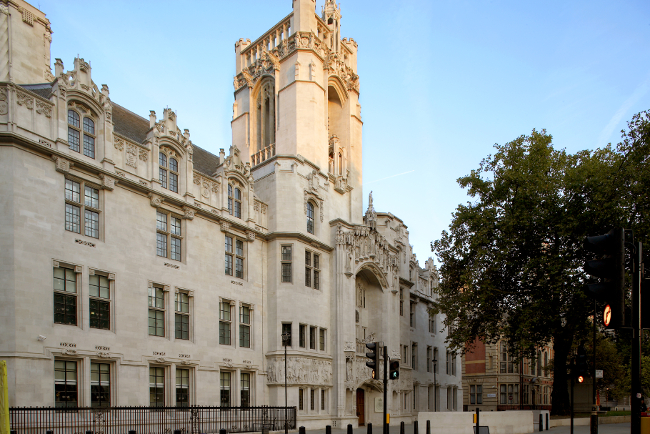Supreme Court finds part-time music teacher entitled to same holiday pay as full-time worker

Credit: Supreme Court
The UK Supreme Court has held that holiday pay for part-year workers is to be calculated on the same basis as full-time employees after dismissing an appeal by the employer of a part-time music teacher against a decision of the English Court of Appeal, and the Employment Appeal Tribunal before it, to that effect.

About this case:
- Citation:[2022] UKSC 21
- Judgment:
- Court:UK Supreme Court
- Judge:Lady Rose and Lady Arden
The Harpur Trust, which appealed a decision that its employee Lesley Brazel had been underpaid her holiday pay, contended that a part-year worker’s leave entitlement must be pro-rated in order to take account of the weeks they did not work. The Employment Tribunal had ruled in the Trust’s favour at first instance but this decision was reversed on appeal.
The appeal was heard by the Deputy President, Lord Hodge, sitting with Lord Briggs, Lady Arden, Lord Burrows, and Lady Rose. Caspar Glyn QC led the appellant’s representation team and Mathew Gullick QC led the team for the respondent. An intervention in the case was made by the trade union UNISON, represented by Michael Ford QC and Mathew Purchase QC.
More favourable method
Since September 2002 the respondent had worked at Bedford Girls School, run by the appellant, as a teacher of saxophone and clarinet, working different hours per week depending on how many pupils needed lessons in her instruments. Under the terms of an employment contract dated to April 2011, she had no guaranteed minimum hours of work and no normal hours and was entitled to 5.6 weeks of paid leave per the Working Time Regulations 1998.
In September 2011 the appellant changed its method of calculating the respondent’s annual leave entitlement to take 12.07 per cent of her hours worked and pay her the hourly rate for that number of hours. The previous method had been to calculate her average weekly pay over a 12-week period and then multiply that by 5.6. As a result, she brought an Employment Tribunal claim for unauthorised deduction of wages.
The appellant’s position was that the method it had adopted was recommended by Acas in its guidance on holiday pay, although the relevant part of the guidance was later rewritten and 2020 guidance from the Department for Business, Energy and Industrial strategy was in line with the Court of Appeal’s decision in the case. The Court of Appeal recognised that the previous method put the respondent in a more favourable position than some full-time workers but held there was not sufficient reason to depart from the statutory scheme under the 1998 Regulations.
It was contended by the appellant that, as the 1998 Regulations were enacted in part to implement the EU Working Time Directive, retained following Brexit, the Supreme Court should apply the “conformity principle” arising from EU case law on the Directive. The amount of annual leave, and therefore holiday pay, ought to reflect the amount of work actually performed, and to allow otherwise would lead to an absurd result.
Not required by EU law
In a joint opinion with which the other three judges agreed, Lady Rose and Lady Arden said: “In our judgment, the conformity principle enunciated by the CJEU cannot operate so as to allow a construction of the provisions so that they apply to part year workers in the way that the Harpur Trust contend. It is not enough for the Trust to show that the Court of Appeal’s interpretation leads to the part-year worker receiving disproportionately more paid leave than other workers.”
They continued: “Given that, as we have said, a more generous entitlement for part-year workers would not infringe either the WTD or the Part-time Working Directive, the issue is one of statutory interpretation. It is not sufficient simply to assert that the conformity principle offers a simple, principled solution to all working patterns unless they can show that the provisions are drafted on the basis that that is the principle underlying the provisions and so should be applied.”
On how to apply the WTR, they said: “The calculation of the entitlement to annual leave is different from the calculation of average pay in this regard. In short, the amount of leave to which a part-year worker under a permanent contract is entitled is not required by EU law to be, and under domestic law is not, prorated to that of a full-time worker.”
Addressing the proposed alternate methods put forward by the appellant, they added: “The methods proposed are very different from the statutory method set out in the WTR. We agree with Mrs Brazel’s description of these methods as an entirely new scheme for calculating holiday pay entitlement. We would go further and say that in a number of ways the methods are directly contrary to what is set out in the WTR.”
The judges concluded: “There is nothing in the WTR which indicates that the regulations should be construed so as to permit the alternative methods of calculating pay that have been adopted or proposed by the Harpur Trust and aspects of their proposed methods are directly contrary to what is required by the statutory wording and the WTR. In short, the amount of leave to which a part-year worker under a permanent contract is entitled is not required by EU law to be, and under domestic law is not, prorated to that of a full-time worker. Accordingly, we dismiss this appeal.”





